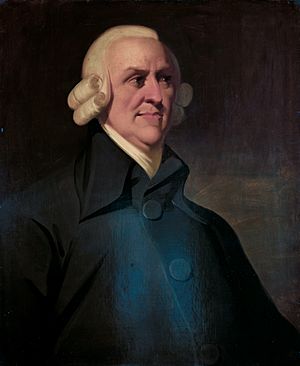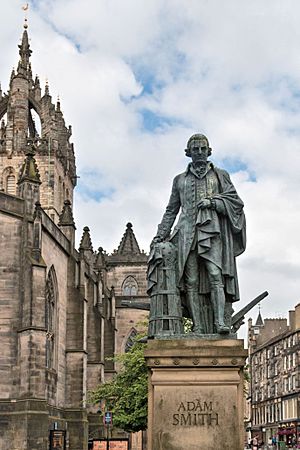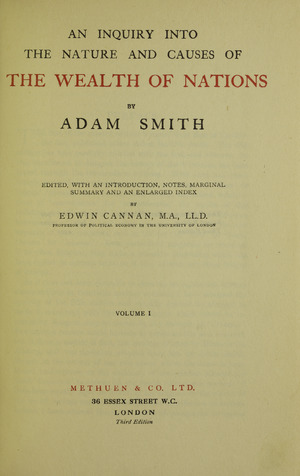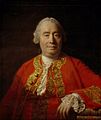Adam Smith facts for kids
Quick facts for kids
Adam Smith
|
|
|---|---|

Portrait of Adam Smith by an unknown artist (Scottish National Gallery)
|
|
| Born | c. June 16 [O.S. c. June 5] 1723 |
| Died | July 17, 1790 (aged 67) Edinburgh, Scotland
|
| Nationality | Scottish |
| Alma mater | University of Glasgow Balliol College, Oxford |
|
Notable work
|
The Wealth of Nations The Theory of Moral Sentiments |
| Region | Western philosophy |
| School | Classical liberalism |
|
Main interests
|
Political philosophy, ethics, economics |
|
Notable ideas
|
Classical economics, free market, economic liberalism, division of labor, absolute advantage, The Invisible Hand |
| Signature | |
Adam Smith (June 16, 1723 – July 17, 1790) was a Scottish economist, who is called the Father of Modern Economics. He was also a philosopher who wanted to know why people thought (felt) that some things are good and others bad.
He is best known for his important book, An Inquiry into the Nature and Causes of the Wealth of Nations, published in 1776. People call the book The Wealth of Nations. It stated some of the ideas on which modern economics is based, especially market economics.
In the Wealth of Nations, Adam Smith asks, "What can a person do that is best for his country?" He decides that if every person does what is best for themselves and their little circle of family and friends, then the country will do better. This is because every person knows about their situation (what they need and what they want, what works and what does not work): much more than the government knows.
Contents
Early Life
Adam Smith was born in Kirkcaldy, Scotland. The exact date of his birth is unknown, but he was baptized on June 16, 1723. His father, also Adam Smith, died just two months before he was born, leaving his mother, Margaret, a widow. From 1729 to 1737, he attended the Burgh School of Kirkcaldy and learned Latin, mathematics, history, and writing. When Smith was 14, he began attending the University of Glasgow in Scotland. There he studied moral philosophy under the famous philosopher Francis Hutcheson. He later went to Oxford University in England, but he thought the teaching was better at the University of Glasgow.
Teaching Career
Adam Smith began giving lectures at the University of Edinburgh, in Scotland, in 1748. He met David Hume in 1750. Hume and Smith became good friends because they shared a love for philosophy and economics.
In 1751, Smith became a professor at his beloved Glasgow University, where he became the head of Moral Philosophy. After he published his first book, The Theory of Moral Sentiments, he began to teach more about economics and jurisprudence (the theory and philosophy of law) in his classes. In 1762, he earned the title of Doctor of Laws (LL.D.) at Glasgow. Shortly afterward, he resigned from teaching at the university and began tutoring Henry Scott, the nephew of Charles Townshend.
Books
While Smith was teaching at Glasgow, he published a book called The Theory of Moral Sentiments in 1759. This book discussed mutual sympathy, or empathy, which is the ability to share the feelings that are being felt by another person. His book made him so popular that many wealthy students left their schools in other countries to come and study at the University of Glasgow.
After Henry Scott's younger brother died in Paris, Adam Smith returned home to live with his mother and to write his most famous work, An Inquiry into the Nature and Causes of the Wealth of Nations. This book is usually called The Wealth of Nations. In it, Smith described some new economic ideas that still influence societies today. Here are three:
- Gross Domestic Product: This was a new idea for how to measure the wealth of a nation. Rather than measuring how much gold or silver a nation had, Smith wrote about the idea to measure the amount of goods and services that a nation creates. This moving of goods and services is called the "Gross Domestic Product" (GDP) of a nation. Today, the GDP is used by most nations to help determine the success of their economy.
- Division of Labor: Smith describes the importance of dividing labor to produce goods, or products. By dividing up the labor, people can focus on something specific rather than many different parts of a job. This helps them work faster and better. He believed that when everyone focuses on one thing and they become good at it, they can put all of those parts together for the best product.
- Invisible Hand: Smith talks about the idea that when a person buys something for himself, he helps the economy as a whole. For instance, when we buy groceries so that we can eat (which benefits us), we are also helping to pay grocery stores and farmers so that they can buy the things they need. The invisible hand is helping everyone when everyone helps themselves.
Death and Legacy

Adam Smith died in Edinburgh, Scotland, in 1790. His book The Wealth of Nations was the first important book on the subject of economics. Many countries today still use the ideas about market economics that he presented.
Adam Smith quotes
- “Every man lives by exchanging.”
- “Man is an animal that makes bargains: no other animal does this - no dog exchanges bones with another.”
- “It is not very unreasonable that the rich should contribute to the public expense, not only in proportion to their revenue but something more than in that proportion.”
- “Though our brother is upon the rack, as long as we ourselves are at ease, our senses will never inform us of what he suffers."
- "The real price of everything, what everything really costs to the man who wants to acquire it, is the toil and trouble of acquiring it.”
Important facts about Adam Smith
- Adam Smith is called "The Father of Modern Economics."
- Adam Smith was born in Scotland and studied at the University of Glasgow under a famous philosopher named Francis Hutcheson.
- Smith went to Oxford University but thought the teaching was better at the University of Glasgow.
- He taught at Glasgow for several years, and it was there that he wrote the book called The Theory of Moral Sentiments.
- Adam Smith began focusing more on teaching economics and the study of law after his book was published.
- Smith began tutoring Henry Scott after he resigned from teaching at Glasgow.
- After Henry's brother died, Adam Smith returned home to live with his mother and to write The Wealth of Nations.
- The Wealth of Nations gave ideas about economics that are still being used by many countries today.
Related pages
Images for kids
-
François Quesnay, one of the leaders of the physiocratic school of thought
-
David Hume was a friend and contemporary of Smith's.
-
A commemorative plaque for Smith is located in Smith's home town of Kirkcaldy.
-
James Tassie's enamel paste medallion of Smith provided the model for many engravings and portraits that remain today.
-
Later building on the site where Smith wrote The Wealth of Nations
-
Smith's burial place in Canongate Kirkyard
-
The Adam Smith Theatre in Kirkcaldy
-
Statue of Smith built in 1867–1870 at the old headquarters of the University of London, 6 Burlington Gardens
-
Adam Smith's Spinning Top, sculpture by Jim Sanborn at Cleveland State University
See also
 In Spanish: Adam Smith para niños
In Spanish: Adam Smith para niños













